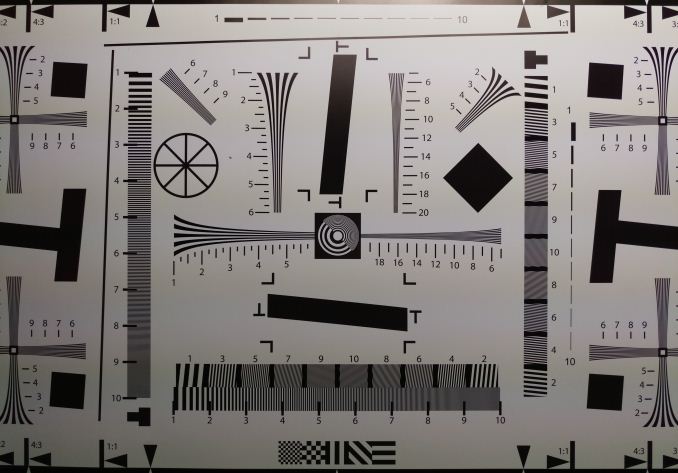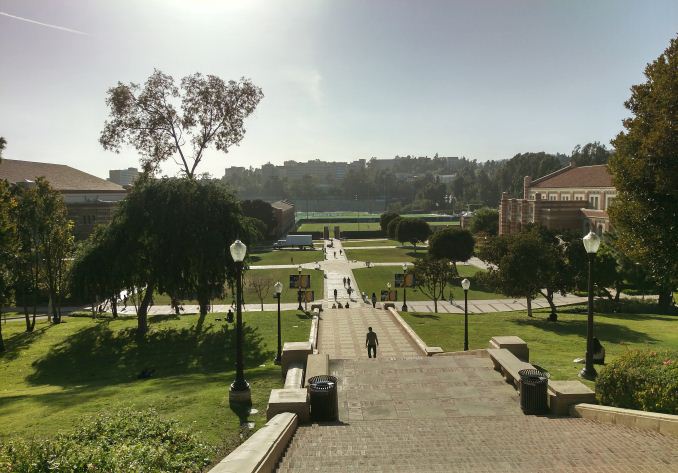The HTC One M9 Review: Part 2
by Joshua Ho on April 6, 2015 10:00 AM EST- Posted in
- Smartphones
- HTC
- Qualcomm
- Mobile
- Snapdragon 810
- One M9
Camera Performance
Now that we've finished going over the camera architecture and user experience of the One M9 we can talk about the end result, namely the quality of the still images and video that the One M9 can produce. Our first test is a basic test of spatial resolution, which uses high-contrast line pairs that make it possible to get a good idea for what the effective maximum resolution of the camera is.
In this test, we can see the benefits of the 20MP camera sensor of the One M9, spatial resolution in this test is a massive improvement over what we saw from the One M8. At the center, the resolution of the camera is sufficient to resolve up to the 20 mark. Resolution at the edges of the frame remains sufficiently high, with no obvious field curvature in this test. To get a more nuanced look of low ISO camera performance, we can look at some standard daytime shots to get a better idea of real-world camera performance.
Here we can start to see some of the real issues with the One M9's camera. It's immediately obvious that the sky here is just the wrong color. Although Los Angeles can be a smoggy place, the sky in this photo should be a stronger shade of blue, not gray with a tinge of blue. Looking at the texture of the roof, the grass throughout the photo, and the bleachers off in the distance, it's pretty obvious that HTC needs to strongly reduce the noise reduction that they're using here, as there's almost no detail in these photos. The detail is basically comparable to the iPhone 6's 8MP camera, which shouldn't be the case in these daytime conditions. The lack of shadow detail also degrades perceived quality. In general, the photo appears to be a bit underexposed as well.
With the HDR mode, all of the issues seen in auto mode are still present. However, to HTC's credit HDR mode is now usable instead of being almost useless as it was with the One M8. HTC still needs to focus on reducing halos as there seem to be issues with this on some high contrast edges/moving objects and make HDR a live preview similar to the Galaxy S5 and S6 camera, but in general this is a dramatic improvement when compared to previous devices.
In low light, the One M9 performs horribly. There's really not much else to be said because there's next to no detail in these photos. Noise reduction has smeared away what detail there was. Despite the fact that the photos have evidence of incredibly strong noise reduction, there's still a lot of noise visible in the image. Thankfully, the color noise of the image is low which makes things better, but for 1600 ISO and 1/9 second exposure time, the output is nothing to talk about.
Moving on the video quality, we can first look at 1080p30 quality. HTC uses a 20Mbps encode rate, using H.264 Baseline for video, and 192Kbps AAC for audio encoding. While the iPhone 6 can serve as a reasonable reference, there are a lot of apparent issues even if one doesn't look to the iPhone 6 for a point of comparison. In general, 1080p video doesn't seem to carry a great deal of detail with it, and it looks like there isn't any kind of video stabilization going on here. The result is that footage is extremely shaky and really kind of disappointing here.
For 1080p60 we can basically see the same story, as the One M9 still has a noticeable lack of detail and there are a lot of problems with camera shake that aren't dampened out. It almost looks like HTC doesn't have any kind of stabilization for video here, which is rather disappointing. The bitrate of 1080p60 footage is also unchanged from the 1080p30 settings, which is a bit curious.
For 720p120 slow motion, HTC does manage to capture real 720p footage instead of upsampled 480p video, and it compares favorably to the iPhone 6 but detail continues to be a problem here. The encoder settings are similar to 1080p30 with its H.264 Baseline setting, but bit rate is reduced to 12.1 Mbps.
Overall, the performance of the One M9's camera is disappointing. Overall, it's still probably better than the One M8's camera, but the execution is lacking. HTC needs to focus on improving detail by avoiding aggressive noise reduction, reduce aggressive sharpening, improve shadow detail, implement effective EIS and OIS, and work on improving auto-focus and capture latency. It's concerning that HTC still cannot come close to the competition in this area, and given that camera is a crucial aspect of any smartphone experience HTC needs to resolve all of these issues if they want to remain relevant in the smartphone market.






































127 Comments
View All Comments
nismotigerwvu - Monday, April 6, 2015 - link
This is quite sad really. Both the HTC devices I've owned (going way back for the 1st with a Windows Mobile 6 packing Mogul/Titan and more recently the OG Evo) have been fantastic pieces of hardware. Perhaps some continued firmware tweaks can bring the camera performance back around, but the SoC really seems to be dragging the model down. Maybe even a midcycle refresh, like and M8+ with a better suited SoC. I haven't looked into it in awhile, but at least a few months ago there were rumors floating around of a new model that massaged the power usage a bit, I think it was being referred to as an 815 but this is purely off memory.DanNeely - Monday, April 6, 2015 - link
Qualcomm is denying that there was ever such a thing as an 815 on their roadmap; and is putting the 820 on the roadmap for retail availability at the end of this/start of next year.http://www.fudzilla.com/news/mobile/37406-there-is...
Laxaa - Monday, April 6, 2015 - link
I really wonder how the rest of this years Snapdragon 810 devices will perform. The LG G4 is even rumored to be using the 808 instead, due to the issues with the G Flex 2.jjj - Monday, April 6, 2015 - link
It's all good, Qualcomm will provide free cases with 60mm USB powered fans for every phone with Snapdragon810.As an alternative they'll also sell phase-change cooling backpacks.
Frenetic Pony - Monday, April 6, 2015 - link
A large part is the Cortex a57 and a53 cores. By all the looks of it Qualcomm could, and should, have stuck with their increasingly aging Snapdragon cores, shrunk the process to TSMC or Samsung's 20nm, and gottent better perf/battery life out it.blanarahul - Monday, April 6, 2015 - link
While it is true that the S810 would have been better with Krait, you have to consider the fact that ARM had already optimized the A57 and A53 cores for 20 nm and Qualcomm would have had to spend additional resources to get Krait to work well on 20 nm which would:-a) Ended up delaying Krait's ARMv8 successor.
b) Not be as efficient because a lot of improvements in Krait 400/300 came from the fact that 28 nm was a mature process and Qualcomm was used to it.
blanarahul - Monday, April 6, 2015 - link
You have to blame HTC to really. They should have compensated for S810 by including panel self refresh and a bigger battery but noooo, they want to make the phone as cheap as possible (display isn't well calibrated remember) and sell well for 700$. Sorry HTC, you aren't getting much money this year.Gunbuster - Tuesday, April 7, 2015 - link
but but but R&D costs money, blah blah blah...Nope they slap the same commodity SOC, screen, battery, and camera together just like everyone else these days. The $600+ phone gravy train is running off the tracks.
skavi - Wednesday, April 8, 2015 - link
They did add a larger battery.TylerGrunter - Tuesday, April 7, 2015 - link
The Krait cores were only competitive against A15 cores due to their ability to run at higher frequency. The issue with that is that 20nm in TSM they only had LPE, which seems to be terrible at high frequency, so they needed to use cores with higher IPC or there would be a huge performance regression and a terrible comparison with A57 cores.